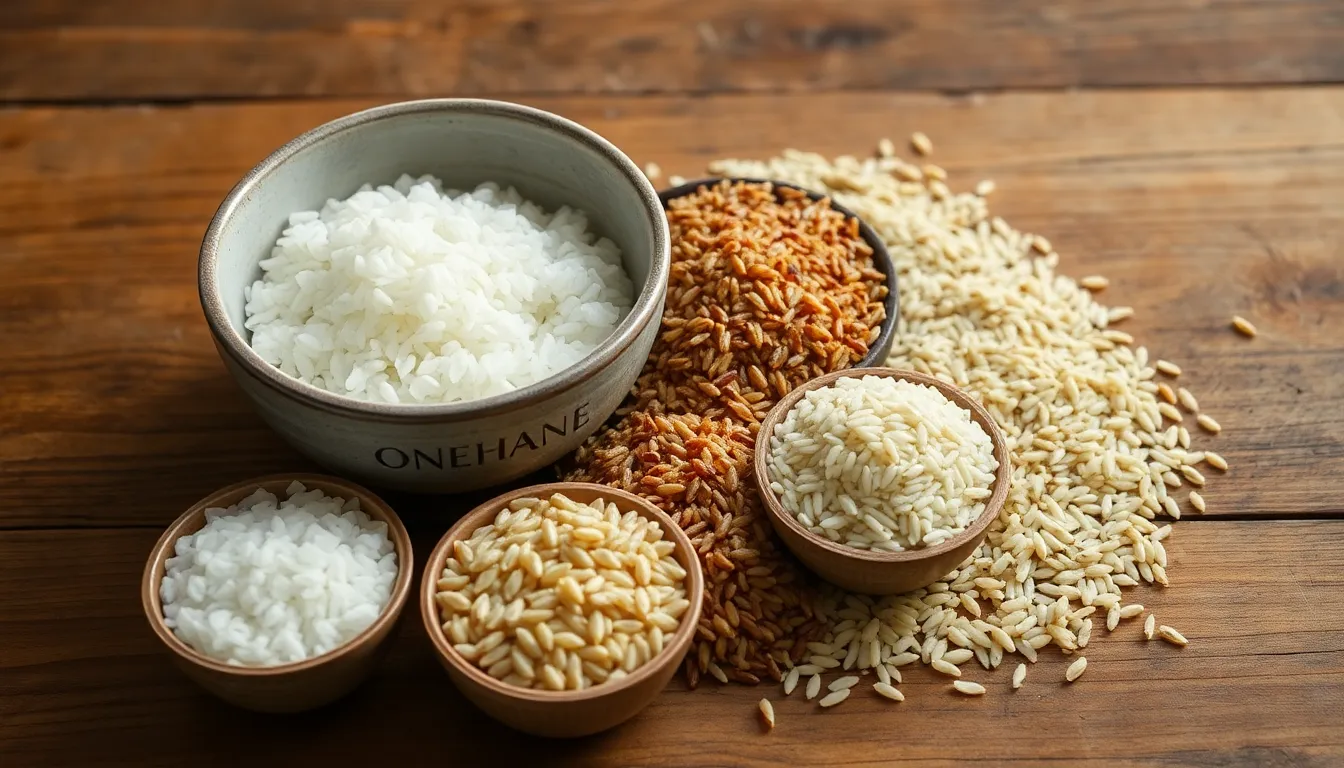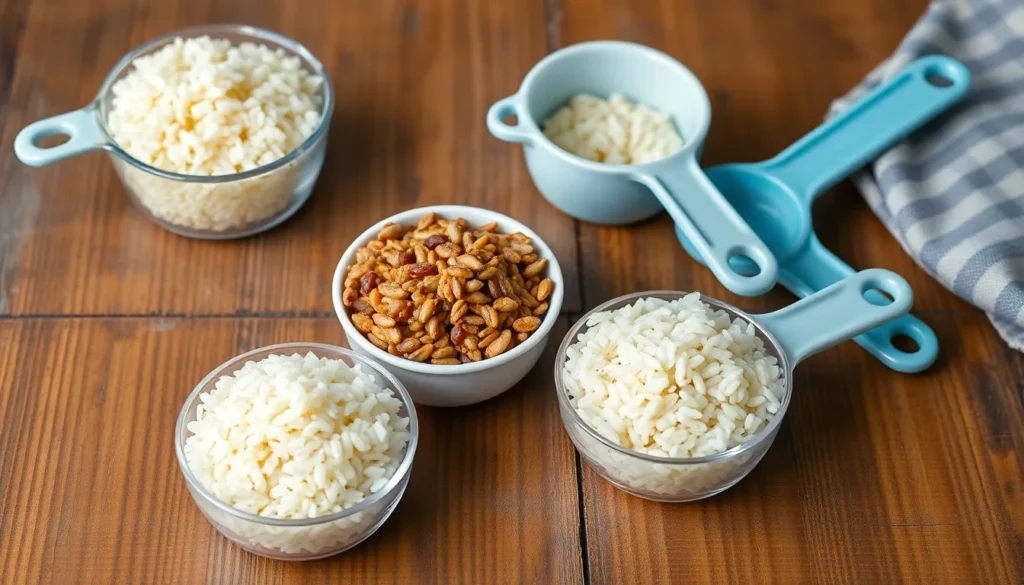Table of Contents
ToggleRice is a staple in many diets around the world, but when it comes to portion sizes, things can get a little tricky. Ever wondered how many calories lurk in that innocent-looking half cup of rice? Spoiler alert: it’s not just a grain of truth! Understanding the calorie content can help anyone navigate their meals like a pro, whether they’re counting calories or just trying to maintain a balanced diet.
Overview of Rice Varieties
Understanding the different varieties of rice helps in counting calories effectively. Each rice type varies in nutritional content and calorie density.
White Rice
White rice is a widely consumed variety. It typically contains around 102 calories in a half-cup serving when cooked. This rice undergoes milling, removing the bran and germ, which strips some nutrients. Low fiber content is a characteristic of white rice, making it easier to digest. Commonly used in cuisines worldwide, it pairs well with many dishes.
Brown Rice
Brown rice offers a more nutritious alternative. A half-cup serving of cooked brown rice has approximately 108 calories. The outer bran layer remains intact, providing fiber and essential nutrients. This type of rice supports better digestion and can contribute to heart health. Its nutty flavor and chewy texture enhance various meals.
Wild Rice
Wild rice stands out due to its unique profile. A half-cup of cooked wild rice contains about 83 calories. Technically a grass, it delivers a distinct taste and additional fiber. Rich in antioxidants, wild rice provides a healthy option in a balanced diet. Often used in salads, soups, and side dishes, it adds variety and nutrition.
Nutritional Breakdown

Understanding the nutritional makeup of rice helps in meal planning. A half-cup serving contains various macronutrients and micronutrients that contribute to its overall value.
Macros in 1/2 Cup Rice
Rice servings provide essential macronutrients. For instance, half a cup of white rice contains approximately 22 grams of carbohydrates, a source of energy. Protein content in white rice is around 2 grams, offering some building blocks for the body. Fat content remains minimal at roughly 0.2 grams. Brown rice, with about 23 grams of carbohydrates, packs in more protein at approximately 3 grams and retains a slightly higher fat content. Wild rice, on the other hand, has fewer carbs, around 18 grams, but still serves 6 grams of protein, providing a robust alternative.
Micronutrients Found
In terms of micronutrients, rice supplies various vitamins and minerals. White rice typically offers small amounts of iron and B vitamins, essential for energy metabolism. Brown rice enriches the diet with magnesium and phosphorus, both vital for bone health. Wild rice stands out for its antioxidant properties and contains higher levels of zinc and vitamin B6. These micronutrients add depth to the nutritional profile, promoting overall wellness.
Understanding Calories
Calories represent a measurement of energy, crucial for understanding dietary choices. They serve as the fuel that powers daily activities and bodily functions.
What Are Calories?
Calories signify the energy provided by food. They play a vital role in maintaining health and well-being. In terms of rice, understanding calorie content helps individuals make informed dietary decisions. One-half cup of white rice contains approximately 102 calories, while brown rice has about 108 calories. Wild rice offers a lighter alternative, with around 83 calories. Recognizing these figures assists in managing energy intake and achieving nutritional goals.
How Calories Are Measured
Measuring calories involves determining the heat energy released during food combustion. This process uses a simple laboratory instrument known as a bomb calorimeter. When food is burned in this device, it produces heat, measured in calories or kilocalories. One kilocalorie equals 1,000 calories, reflecting energy potential in food. Various databases provide estimated calorie values based on standard servings, aiding consumers in tracking nutritional intake accurately.
Factors Affecting Caloric Content
Caloric content in rice varies based on several factors. Cooking methods and additional ingredients play significant roles.
Cooking Methods
Cooking techniques can alter the caloric density of rice. Boiling rice in water generally maintains its calorie count, while sautéing or frying rice in oil adds extra calories. Using broth instead of water introduces additional flavors and potential calories, depending on the broth’s ingredients. Steaming rice retains its health benefits while keeping calories relatively stable. Microwave cooking offers convenience without compromising caloric values, as long as no fats are added. Understanding these methods helps individuals choose how to prepare rice based on dietary goals.
Additional Ingredients
Incorporating other ingredients can dramatically change the caloric content of rice dishes. Adding butter, oils, or sauces increases calories significantly per serving. Vegetables, while nutritious, may not add extensive calories but enhance flavor and fiber. Pairing rice with protein sources such as beans or meats escalates the total caloric load. Dishes like fried rice often contain eggs and other flavorings that also boost calories. Being mindful of these extras is essential for anyone monitoring their caloric intake while enjoying rice.
Health Considerations
Understanding the role of rice in a balanced diet and managing caloric intake is crucial for maintaining health. Caloric content impacts overall nutrition.
Rice in a Balanced Diet
Incorporating rice into a balanced diet can provide essential nutrients and energy. White rice serves as a quick energy source, while brown rice offers fiber and minerals like magnesium. Wild rice stands out with its higher protein content and antioxidants. Combining rice with vegetables and proteins enhances meal nutrition, creating a well-rounded dish.
Caloric Needs and Portion Control
Caloric needs vary based on individual activity levels, age, and health goals. A typical adult generally requires 1,800 to 2,400 calories daily. Using a half-cup serving of rice contributes about 83 to 108 calories to the daily intake. Monitoring portion sizes becomes essential, especially when adding ingredients like oils or sauces. Mindful consumption allows individuals to enjoy rice while managing weight effectively.
Understanding the calorie content in a half-cup of rice is essential for anyone aiming to maintain a balanced diet. With options like white, brown, and wild rice each offering unique nutritional benefits, individuals can tailor their choices to meet specific dietary needs.
Recognizing how cooking methods and added ingredients influence caloric density can help in managing overall energy intake. By practicing portion control and being mindful of how rice fits into their meals, individuals can enjoy this versatile staple while supporting their health and nutrition goals.







